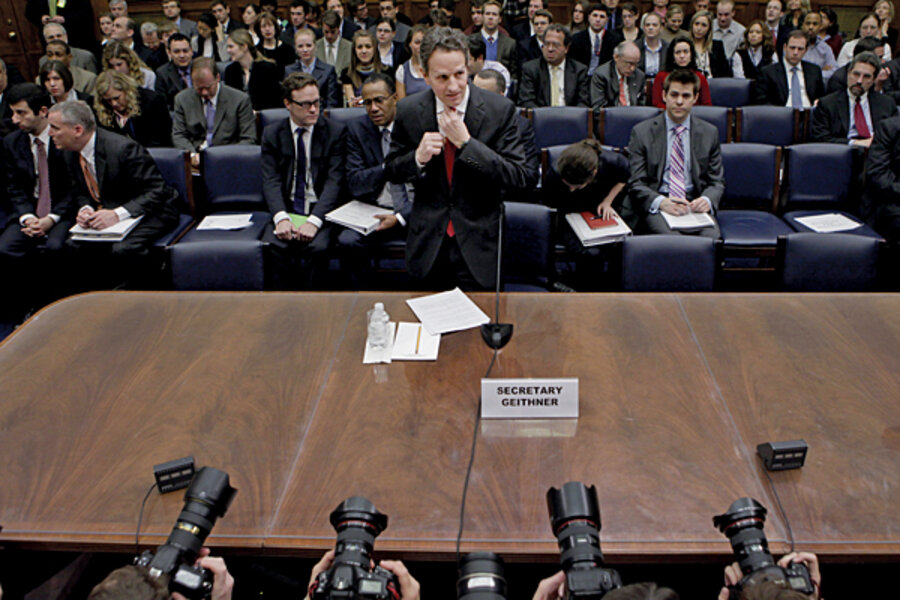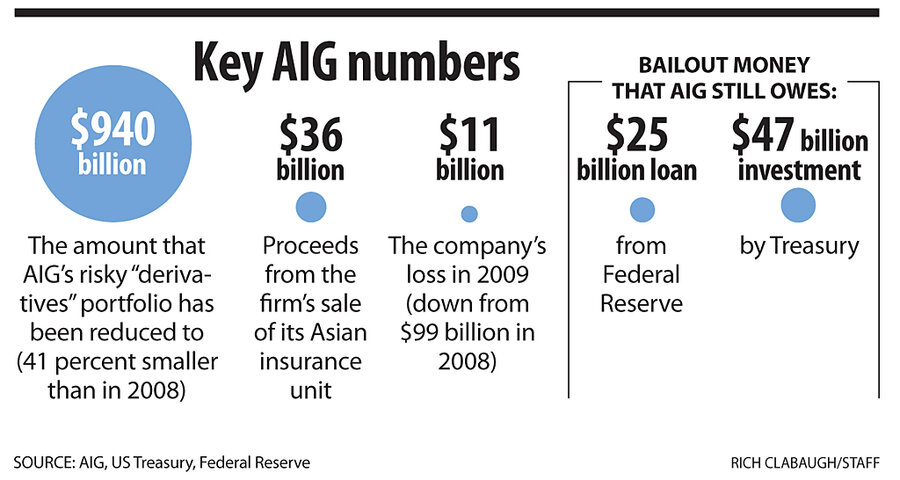AIG restructuring: Can taxpayers recoup bailout funds?
Loading...
“Long live AIG.” That may not be what people want to hear from a firm that received one of the costliest and least popular federal bailouts since 2008. But that unofficial slogan captures the outlook of the insurance firm and, in effect, the view that US taxpayers are being asked to share as its majority owners.
In the past year and a half, the federal government has pledged about $180 billion in bailout money to American International Group Inc., although the firm has tapped less than that so far. AIG owes at least $70 billion.
Despite lots of talk by government officials about “winding down” the giant insurer, what’s been happening instead is a slow restructuring.
It’s true that the firm is trying to sell off assets – the most prominent example coming earlier this month in a $35.5 billion sale of its Asian insurance arm to Prudential PLC. And on Monday, AIG announced plans to sell another overseas unit, Alico, to MetLife for $15.5 billion. But in its latest quarterly report, AIG blended caution flags – including that it might ask for more government aid – with confidence: “We are taking the right steps to regain our stature as one of the most respected and diverse property-casualty operations in the world….”
Thus, AIG’s strategy is revival, not full-scale dismemberment. According to some industry analysts, this gradual make-over is the course that holds the best hope of recouping for US taxpayers the bailout money. (Read here to learn about analysts' predictions of which companies would and would not pay back bailout loans.)
But many hurdles lie ahead. And in the process, the case of AIG continues to symbolize some of the most troubling lessons of the financial crisis. One is that while bailouts can end a financial panic, they don’t necessarily fix underlying problems – either in the broad financial system or within individual firms.
“[AIG] has been bailed out entirely…. Why isn’t it generating an enormous profit?” asks William Black, a financial expert at the University of Missouri in Kansas City.
The answer, he worries, may be that the firm remains riddled with problems despite all the infusions of government support. (Read here to learn about the Obama administration's defense of the AIG bailout.)
AIG’s troubles aren’t confined to the non-insurance activities known as derivatives trades – the investment contracts that, because of their ties to low-quality mortgage investments, pushed the firm to the brink of bankruptcy in September 2008.
In the latest quarter, for example, AIG lost money on its general insurance business, due to the need to set aside reserves to cover any additional losses. Also, its aircraft-leasing division faces a financial squeeze, with the prospect of having to sell commercial jetliners at a loss.
In all, AIG reported a nearly $9 billion loss for the fourth quarter of 2009, and $11 billion in losses for the full calendar year.
That’s about 1/10th the amount AIG lost the year before. So the company at least appears to be making progress, many financial analysts say.
But will taxpayers ever get their money back? That remains far from clear. (Read here to learn about another company that vows to repay its bailout money by June 2010.)
One risk is that federal support encourages AIG to gamble on its recovery plans. If those efforts succeed, the firm can pay back the bailout money and return to private-sector health with gains for its shareholders and employees – the ones who recently got $100 million in controversial bonuses. If the strategy falters, the firm could still win by leaning on the government for more assistance.
That endless-bailout scenario has some critics saying the government should press AIG to sell more assets, and faster, to repay taxpayers. The firm has been paring the size of its derivatives portfolio, but the package of $940 billion in contracts is still more than half the size it was at the end of 2008.
Others defend AIG’s don’t-rush approach to asset sales under CEO Robert Benmosche. “The sale of the Asian life unit is obviously a very positive step” in raising money that can be used to pay back bailout funds, says Cathy Seifert, an equity analyst at Standard & Poor’s in New York.
To date, the US Treasury has invested $47 billion to become 80 percent owner of AIG. Meanwhile, AIG owes the Federal Reserve $25 billion on an emergency line of credit. The Federal Reserve Bank of New York has also bought more than $30 billion in AIG assets to prop up the firm. AIG plans to pay down a large chunk of its obligations to the Fed with proceeds from the Asian unit.
The proceeds from the spinoff of Alico and the Asian insurance arm (called AIA) will come in a mix of cash and securities. Most of the money will be used to pay back additional Federal Reserve aid (so-called "special purpose vehicles" set up for those overseas units of AIG). The rest will go toward paying down the $25 billion loan on the Fed's books.
Bruce Ballentine, a credit analyst at Moody’s in New York, expects several steps to determine how US taxpayers fare in the end. First, he says, AIG will try to enhance the performance of core operations that it plans to keep. Second, the firm will continue to divest noncore assets or “de-risk” them. Third, he says, assuming that the Fed is paid back, the most likely path for the US Treasury would be to convert its stake in AIG into common stock and offer it for sale.
To Mr. Black, who oversaw fraud prosecutions of lenders involved in the 1980s savings-and-loan crisis, the public should have a bigger concern than getting its money back: Is the financial system being made safer? New regulations and tougher accounting standards, drawing lessons from AIG, could be vital steps down that path, he says.






